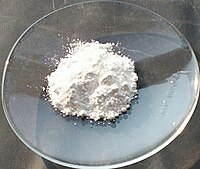
Photo from wikipedia
PURPOSE This study aims to investigate the dose response of diode-type detectors in the presence of strong magnetic field and to understand the underlying mechanisms leading to the observed magnetic… Click to show full abstract
PURPOSE This study aims to investigate the dose response of diode-type detectors in the presence of strong magnetic field and to understand the underlying mechanisms leading to the observed magnetic field dependence by close examinations on the role of the detector's design. MATERIALS AND METHODS Three clinical diode-type detectors (PTW microSilicon type 60023, PTW microDiamond type 60019, and IBA Razor Diode) have been studied. Measurements were performed at the linear accelerator experimental facility of the German National Metrology Institute (PTB, Braunschweig) with electromagnets up to 1.4 T to obtain the magnetic field correction factors ꓗB,Q . The experimental results were compared to Monte Carlo simulations. Stepwise modifications of the detectors' models were performed to characterize the contributions of the structural components towards the magnetic field dependent dose response. Additionally, systematic Monte Carlo study was conducted to elucidate the influence of the structural layers with varying density located above and beneath the detector's sensitive volume. RESULTS The dose response of all investigated detectors decreases with magnetic field. As a result, the associated ꓗB,Q factors increase by approximately 10% for the PTW detectors, and by 5% for the IBA Razor diode at 1.5 T. The sensitive volume itself was shown to cause negligible effect but the diode substrate with enhanced density situated directly below the sensitive volume contributes strongest to the observed magnetic field dependence. Systematic simulations revealed that ꓗB,Q increases with magnetic field if the density of the structural layer located beneath the sensitive volume is higher than that of normal water (> 1 g/cm3 ). In the case where the layer consists of low-density water (1.2 mg/cm3 ), ꓗB,Q decreases with the magnetic field strength. On the other hand, if the structural layer with varying density is situated above the sensitive volume, the reversed effect could be observed. DISCUSSION AND CONCLUSION The experimental and Monte Carlo results demonstrated that the dose response of the investigated diode-type detectors decreases in magnetic field. This observation can be generally attributed to the common construction of diode-type detectors, where structural components with enhanced density, for example the diode-substrate, are situated below the sensitive volume. The results provide deeper insights into the behaviour of clinical diode detectors when used in strong magnetic field.
Journal Title: Medical physics
Year Published: 2020
Link to full text (if available)
Share on Social Media: Sign Up to like & get
recommendations!